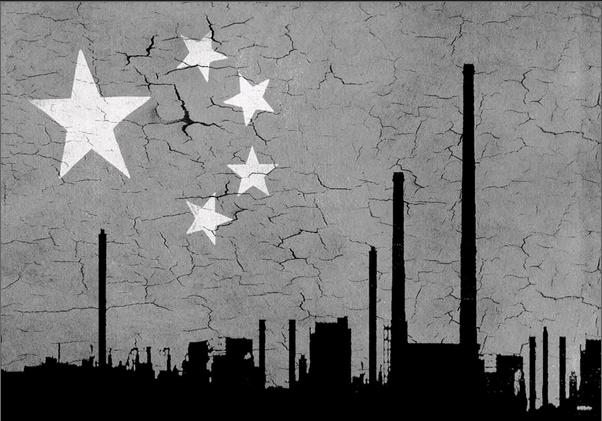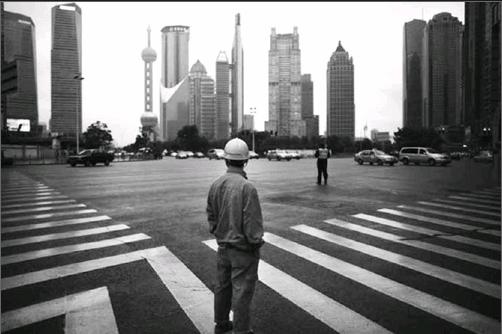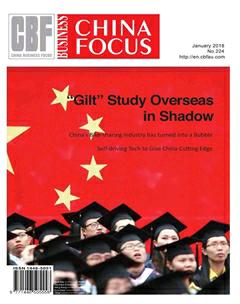How Can China Achieve High-Quality Growth?



Chinas annual Central Economic Work Con- ference, a key event to review the countrys economic performance and discuss new directions, ended last week. Following the Communist Partys 19th National Congress in October, the conference reiterated the declaration that Chinas economy has been transforming from high-speed to high-quality growth. The meeting also laid out plans for the countrys economic work in 2018, centering on how to achieve quality growth.
So how exactly can China make high-quality growth happen? The answer is obvious: deepening comprehensive reform and opening-up, and nurturing a new economy boosted by technology, recreation and other new drivers.
In fact, shifting to high-quality growth is more of the setting of a goal than a conclusion of what has happened. Highquality growth implies high efficiency, intensive operation, a proper economic structure, and powerful and sustainable development. It does not happen overnight, but takes perseverance and determination.
The conference last week stressed that quality growth will be the principal requirement when drafting development plans or economic policies for years to come. A number of parameters will be designed shortly to assess the quality of economic growth. As long as economic growth stays within a reasonable range, the decision-makers will be more tolerant about slowing growth than they were before. Of course, balancing speed and quality will be an arduous task, as hidden dangers, known as “black swans,” and obvious but often-neglected threats, known as “gray rhinos,” often stand in the way.
China has been exploring paths to enhance the quality of its economic development for years. More than two decades ago, the government stated in its Ninth Five-Year Plan (1996-2000) that the country would seek a shift from extensive economic growth to intensive growth. In the 21st century,“changing the economic growth mode” has been a main theme in economic policies. Quality growth is an inevitable and much-needed choice for China to step up its game.
China is ready to do so now. The countrys per capita gross domestic product (GDP) has surpassed $8,000. The country has been investing heavily in science and technology; enterprises boasting world-class technological capability have been sprouting up in China; cities featuring creativity and innovation have been taking shape. The country has been embarking on the right track to seek high-quality growth. However, the transition has just started, while challenges remain formidable. China has been investing a higher rate of energy and resources to produce goods than many developed countries have, which has resulted in serious pollution and ecological damage. The unbalanced development has not fully met peoples need for a quality life.endprint
The latest Mastercard Caixin BBD China New Economy Index showed that new-economy industries that feature “high human resources investment, high technology investment and light capital” account for only about one-third of the entire economy, in some months even falling below 30%. It indicated that the progress in embracing the new economy is yet to be achieved. To ensure quality growth, China has to uphold and deepen reform and opening-up, and as the Central Economic Work Conference said, the nation has to “clear out discriminating restrictions or other hidden hurdles.” The conference also urged a faster pace and intensity in structural reform, which will focus on improving the property-rights system and the role of the market in allocating resources. These plans do address the right issues, but whether the goals can be achieved depends on how the plans are carried out.
The conference has put reform of the supply chain on top of eight tasks it has laid out. To give the market a greater role, the government will try to take out ineffective supplies by phasing out “zombie enterprises” that have been hopeless money-losers for years. The government will also foster new economic drivers by helping upgrade traditional industries and boosting technological innovation. The authorities will also reform monopolistic industries like power and transportation to lower costs for other companies. If these measures are effectively carried out, Chinas economy will see renewed growth momentum.
The conference also stressed that the reform in stateowned enterprises will focus on the management of “state capital” instead of the operation of state-owned enterprises. The government also emphasized the protection of property rights in order to ensure healthy growth of private enterprises. The government will also continue to improve a “negative list” for market access so that companies of different ownership can have fair competition and the countrys economy can be invigorated.
The structural upgrade of Chinas economy comes along with the upgrade of development quality. It also needs a higher level of systemic reform. In recent years, services have overtaken industry to become the largest contributing sector to Chinas GDP. The development of the modern service industry can enhance the efficiency of the entire economy. Compared with the era dominated by the industrial sector, the new era of an economy led by the services sector will be more sophisticated and involve more transactions between different individuals, which requires more guarantees for contract enforcement. This puts a higher requirement on the countrys standards for rule of law and governance. The new situation needs the government to change its role, making itself a limited government that aims at providing better service.endprint
Raising economic development quality cannot be realized behind a closed door. It has to be tested in international competition. The conference vows to open the country further up to the outside world and “ease up market access to a larger scale” in a bid to speed up the process for “all-over openingup.” It is clear that Chinas determination to further open up will not waver despite geopolitical changes from outside.
2018 marks the 40th anniversary of Chinas launching its transition from a rigid planned economy. Letting the market play a decisive role in market allocation and let the government better fulfill its own function is a hard-won basic principle. A market economy has intrinsic motivation to raise efficiency, and the government should work hard on creating and improving the environmental framework.
Shifting from rapid growth to quality growth is a step as well as a hurdle. To clear it, Chinas economy will embrace a new space and momentum. The result depends on the effectiveness of the government reform.
China is likely to set its target for money growth next year at around 9%, the lowest ever, as the country works to rein in the accumulation of debt and prevent the growth of asset bubbles, the official China Daily reported Monday.The report comes after top leaders at the Central Economic Work Conference — a key annual meeting to chart major economic policies for the coming year — vowed last week to impose a tighter grip on the money supply in 2018 from this year. Policymakers listed fending off major risks, especially financial risks, as their top priority over the next three years. Financial risks have become the largest threat to Chinas economic stability in the medium and long term, Li Yang, director of the National Institution for Finance and Development under government think tank the Chinese Academy of Social Sciences, said in the China Daily report. Li was among the economists involved in high-level policy discussions before the conference last week, the report said. The expansion in Chinas M2, a broad measurement of the money supply that includes cash in circulation and all deposits, has slowed sharply this year as regulators crack down on risky operations in the financial sector, especially those related to shadow banking and wealth management products. M2 grew 9.1% in November, up slightly from 8.8% in October, which was the slowest pace since records began in 1996. It remained below the governments target of a growth rate of around 12% this year. Yi Gang, a deputy central bank governor, on Saturday said this years decelerating M2 growth has been a result of the financial deleveraging campaign. “(The slowdown) mainly reflected that the leverage ratio within the financial sector has been controlled,” Yi said at a conference. “The 9.1% growth rate for M2 is normal,” he added.endprint
The Central Economic Work Conference, held in Beijing in mid-December, set the tone for economic development in 2017. Some new messages from this policy conference merit close examination.
The meeting set the tone -- seeking progress while maintaining stability. This is the first time that “seeking progress while maintaining stability” was upgraded to an unprecedentedly high status, that is, from a methodology for economic work to an important principle for governance.
For this principle, “stability” is the theme and the objective. To be specific, stability means that the economic performance will be steady, the fiscal policy “more proactive and effective” to serve the supply-side structural reform, the monetary policy “prudent and neutral”, taxes and administrative fees further reduced, money supply and credit size kept at an appropriate level, and interest rates and exchange rates relatively stable.
“Progress” is reflected by the expansion of the supplyside structural reform to agriculture, rejuvenation of the real economy and the creation of a long-term mechanism for maintaining stable and healthy development of the property market. It means that breakthroughs should be made in the reforms of such important sectors as State-owned enterprises, finance, taxation and elderly care services.
Based on the overall tone, this writer believes that Chinas economic growth rate in 2017 will be lower compared against 2016, probably between 6.5% and 6.6%, and that the countrys economy has yet to bottom out. In the coming few years, the GDP growth is expected to range between 6% and 7%, with short-term fluctuations highly probable.
Policymakers have concluded to continue with the tasks of cutting industrial overcapacity, bringing down housing inventory, reducing leverage levels, lowering corporate costs and improving weak economic links in 2017. The key to cutting overcapacity is to eliminate the “zombie enterprises”. The country used to rely on administrative tools to cut overcapacity, but in the future, it must gradually adopt and adapt to the market and legal approaches in reducing overcapacity. No doubt, if the government provides some financial support, it will be of tremendous help for the enterprises in the resettlement and reemployment of laid-off workers, but this is just a temporary or transitional measure and it could not be considered a cure to the enterprises chronic problem of a lack of the self-sustaining power. Therefore, in the process of cutting overcapacity, the priority for the government is to formulate and enforce standards relating to environmental protection, energy consumption, safety and quality, and let the market to play its role in the process, where reorganization and bankruptcy will be applied.endprint
Deleveraging is mainly to lower the leverage levels of State-owned enterprises. One of the important approaches to deleverage is the debt-for-equity swap. This plan, however, is not designed to help the enterprises dodge their debts, but to better protect the interests of creditors. Under the scheme,strategic investors will be brought in to improve the enterprises equity structure and governance, to improve te enterprisesown “blood-making” capability, and to stimulate and enhance their self-development capacity and their innovative vigor.
At present, the leverage level of State-owned enterprises is generally high, and should be lowered by five to 10 percentage points in the next few years. Of course, the leveraging levels among enterprises in different industries and different regions could vary remarkably.
Apart from the debt-for-equity swap plan, another important means for deleveraging is to develop the equity investment market so as to help enterprises raise fund directly from the market.
A “proactive and effective” fiscal policy has been proposed. This is the first time that the word “effective” is used to define the fiscal policy. By effective, it means the policy should be more targeted, and should serve the supply-side structural reform, with priorities on lowering corporate costs and improving weak economic links.
A proactive and effective fiscal policy implies, by no means, any unrestricted rise in deficits. In my opinion, the annual rate of fiscal deficit should not exceed 3% of the GDP. With an economy big and growing like that of China, a 3% deficit today could mean a much, much bigger debt size in absolute value compared with a similar percentage of deficit in the past years.
While emphasizing an increase in fiscal expenditure, we should pay more attention to how to attract and guide social capital into the fields with direct bearing on peoples livelihood, including the public-private partnership that is widely encouraged.
A prudent and neutral monetary policy is now in place. Zhou Xiaochuan, the governor of the Peoples Bank of China or the central bank, characterized the monetary policy into five broad categories -- loose, tight, neutral, moderately tight and moderately loose. The prudent and neutral monetary policy set at the meeting fits the third category. It is predicted that the growth rate in M2 supply in 2017 will range between 11% and 13%.endprint
The meeting said the monetary policy should “adapt to the new changes in the methods of money supply”. This deserves our special attention, because it means that against the backdrop of a depreciating renminbi and capital outflows, the central bank will resort to cuts in reserve requirement ratios and open market operations as the main methods for money supply in 2017.
By prudent, it means that money supply, credit size, interest rates and exchange rates should all be maintained at an appropriate level and be relatively stable, and big fluctuations should be avoided. To maintain stable exchange rates, we should peg the renminbi to a basket of currencies. In 2016, the renminbi depreciated significantly against the US dollar and likely the depreciating trend is to continue in 2017. However it is highly unlikely for the renminbi to weaken below the threshold of 7.3 yuan to one dollar.
The dollar index has already risen above 103, but it is unlikely that the renminbi will keep weakening against the dollar. A rising dollar may also fluctuate. When Donald Trump takes office, it is believed that he would adopt an expansionary fiscal policy and a contractionary monetary policy. As a result, the United States may see a surge in both fiscal deficit and current account deficit, which may lead a depreciation in the dollar.
Languages such as “houses are built to be inhabited, not for speculation” are pretty clear in the document released after the economic conference. For the property industry, the government has called for the creation of basic institutional systems and long-term mechanism that both accommodate Chinas national conditions and comply with market rules.
Growth in investment in real estate in 2016 was expected to be around 6%, and a growth rate of 4% to 5% is anticipated for 2017. Such a growth is high enough to maintain some stability in the sector, and would not lead to big fluctuations.
With the deepening of the supply-side reform for agriculture and the new type of urbanization, farmers income will rise, making it a reality that more and more farmers will be financially capable of buying houses in towns and cities.endprint

